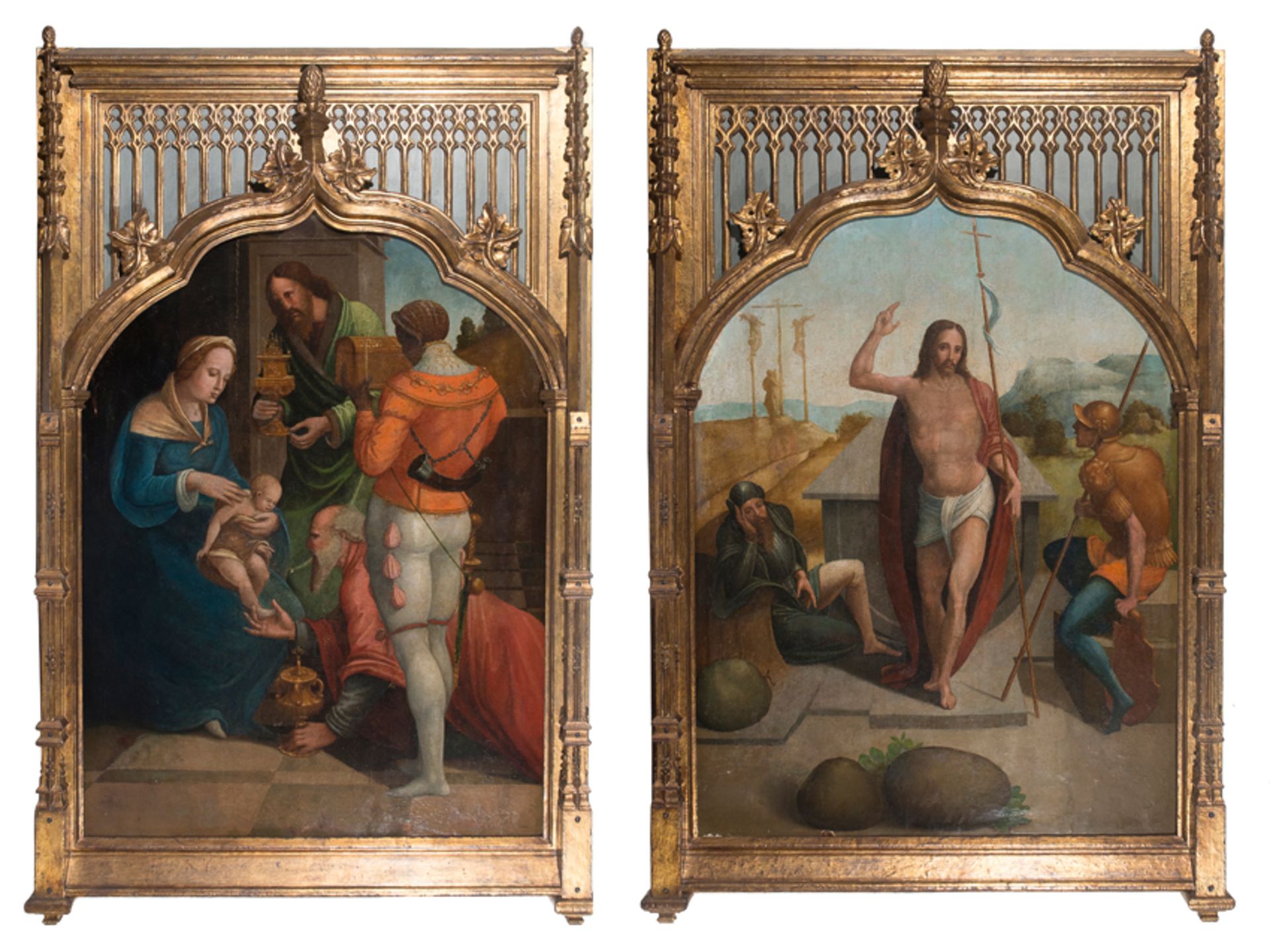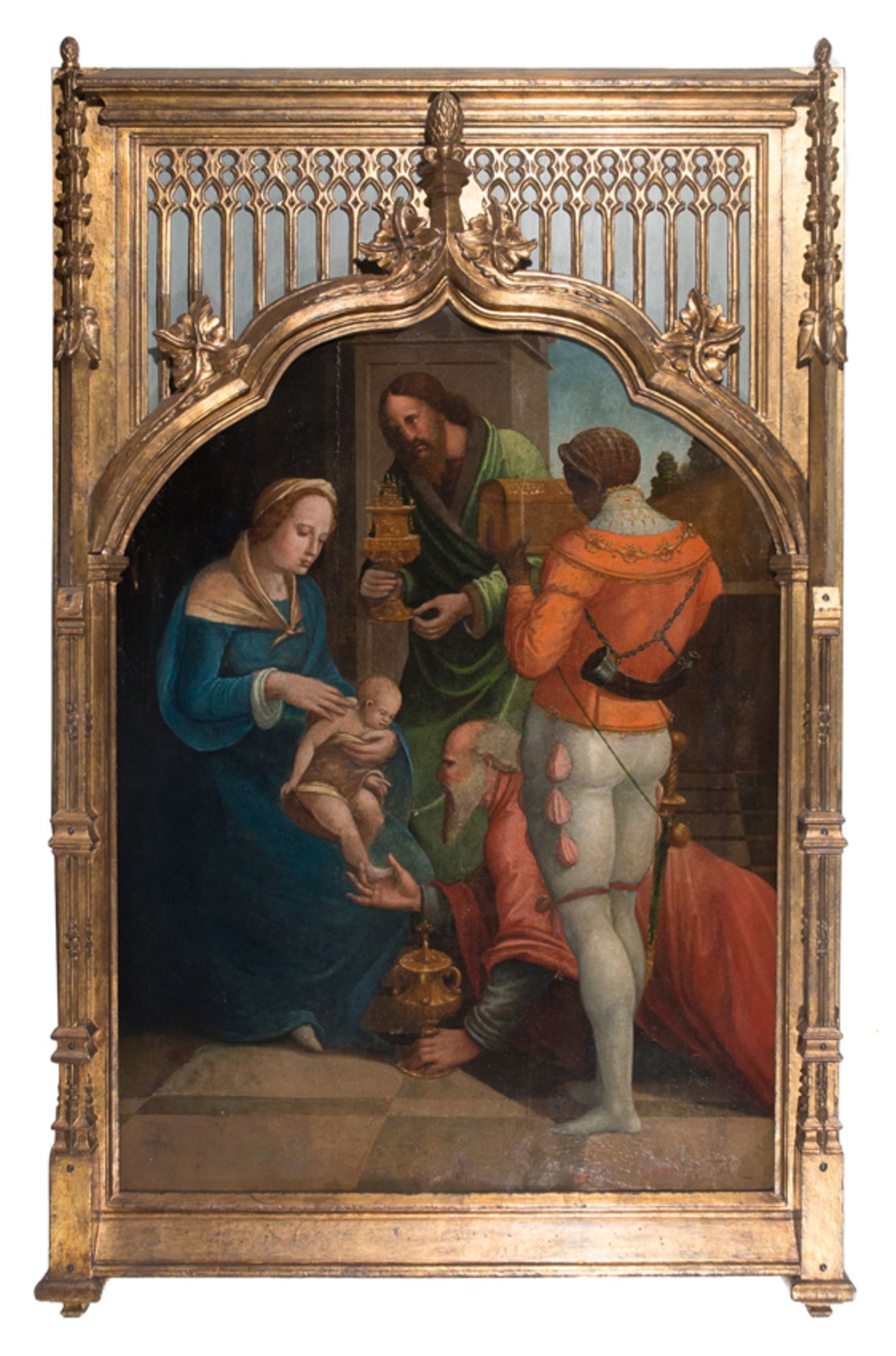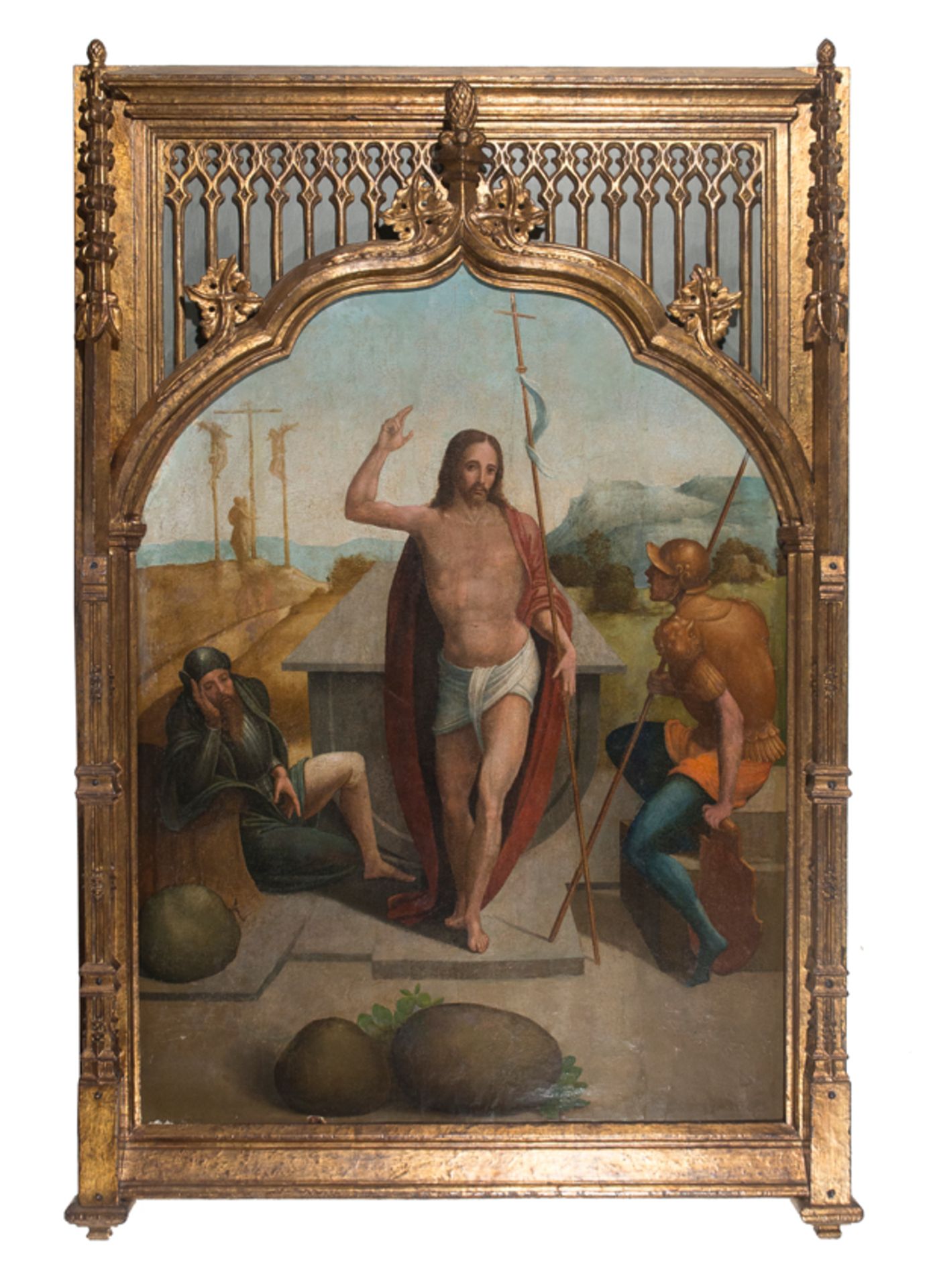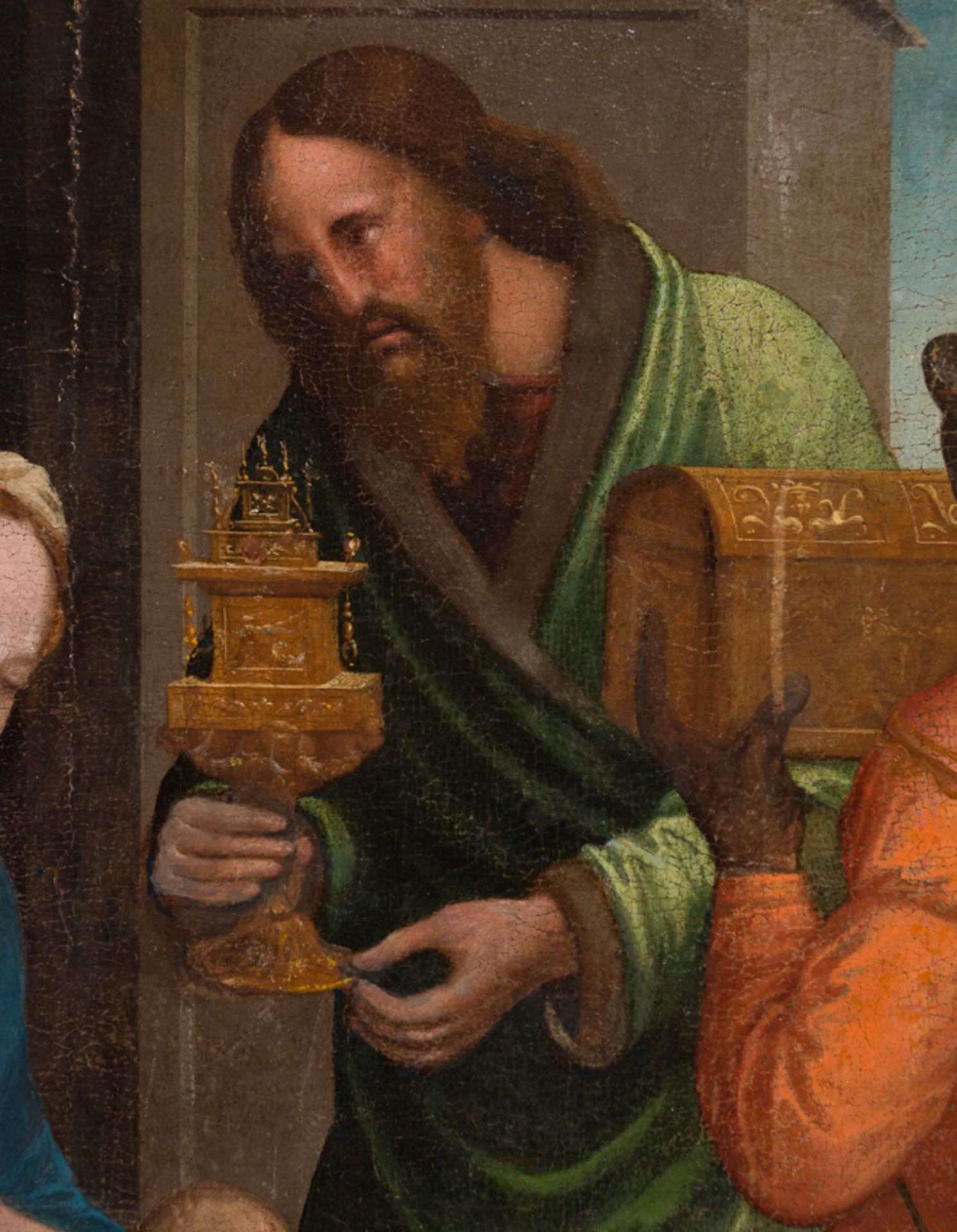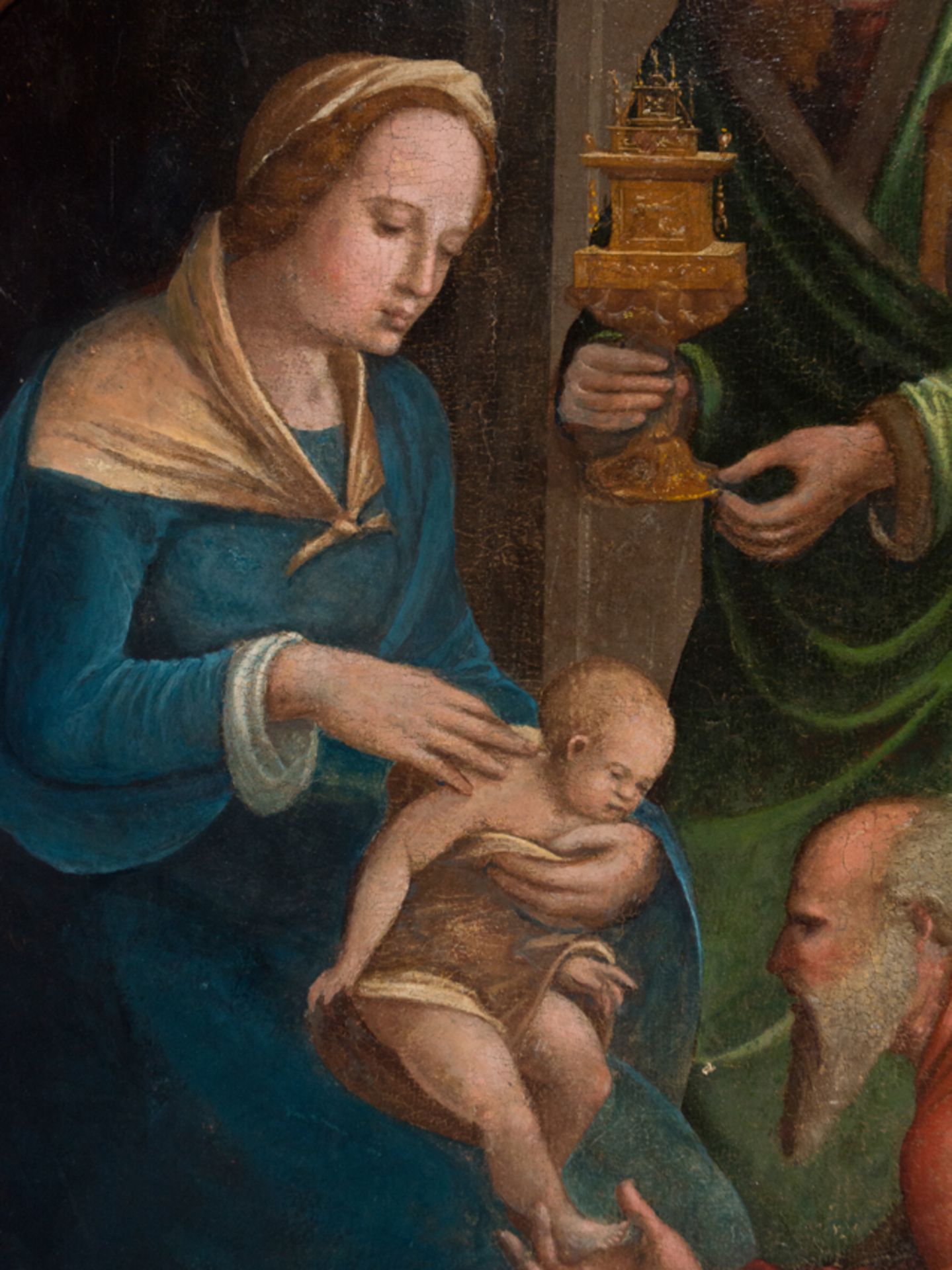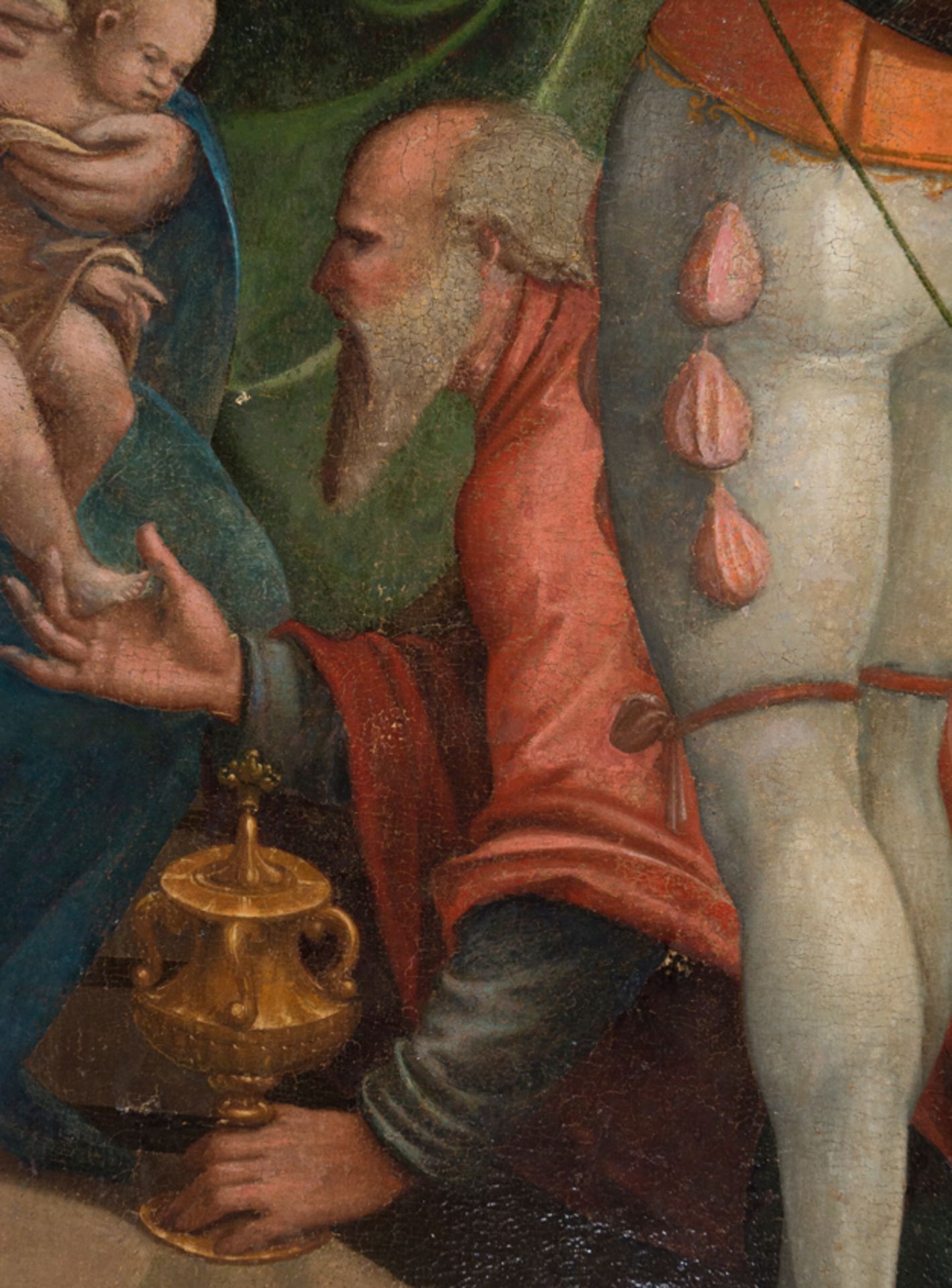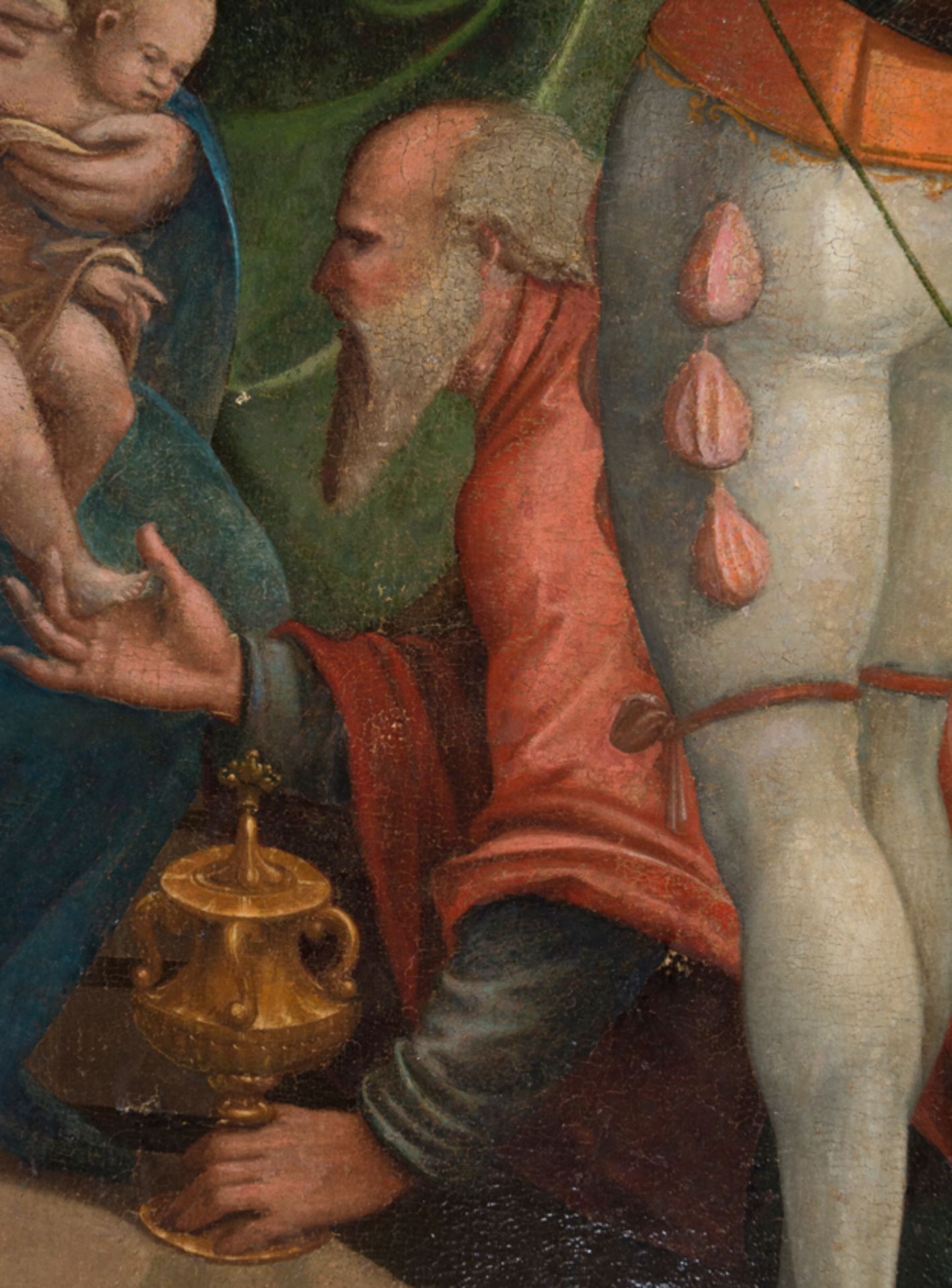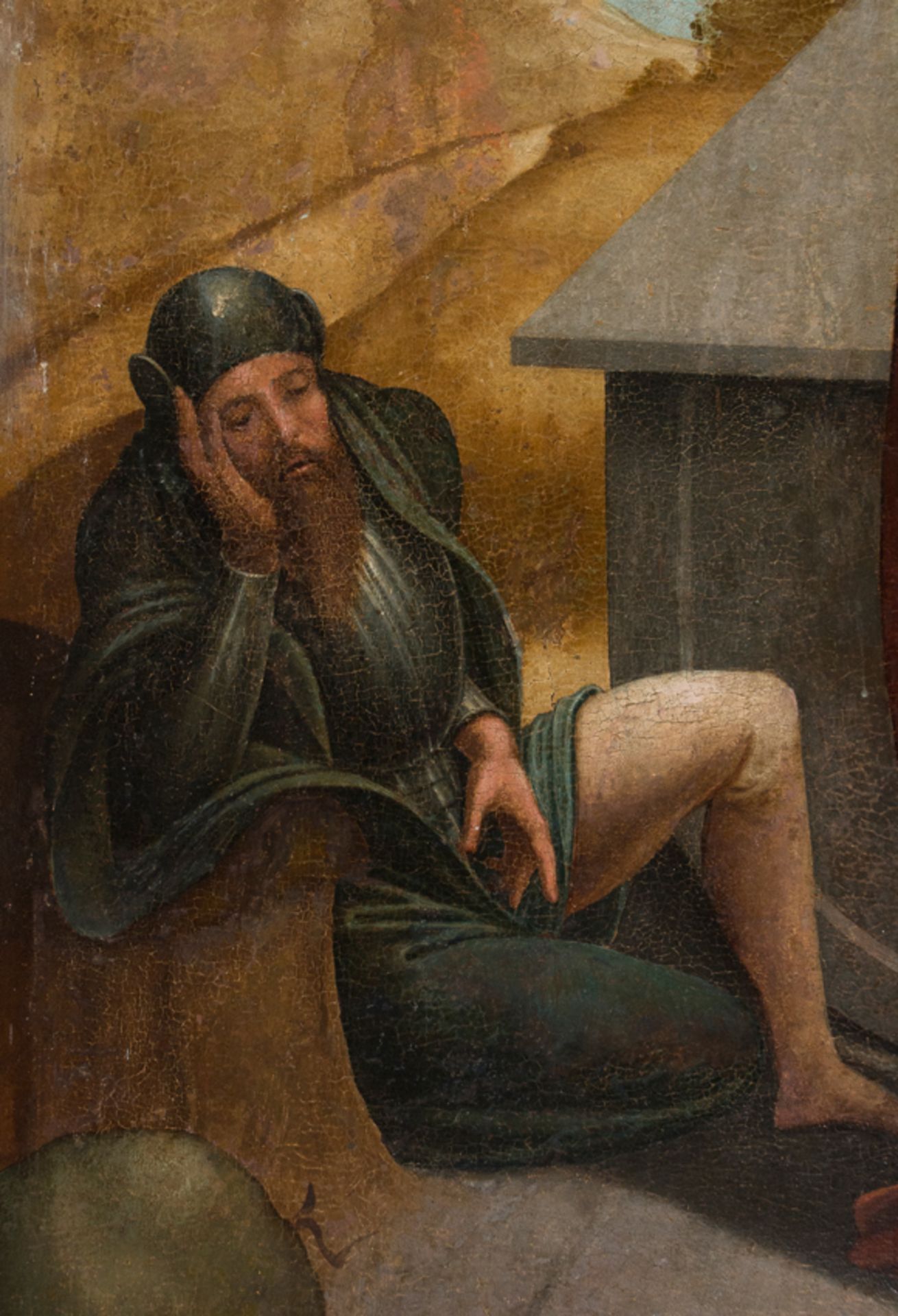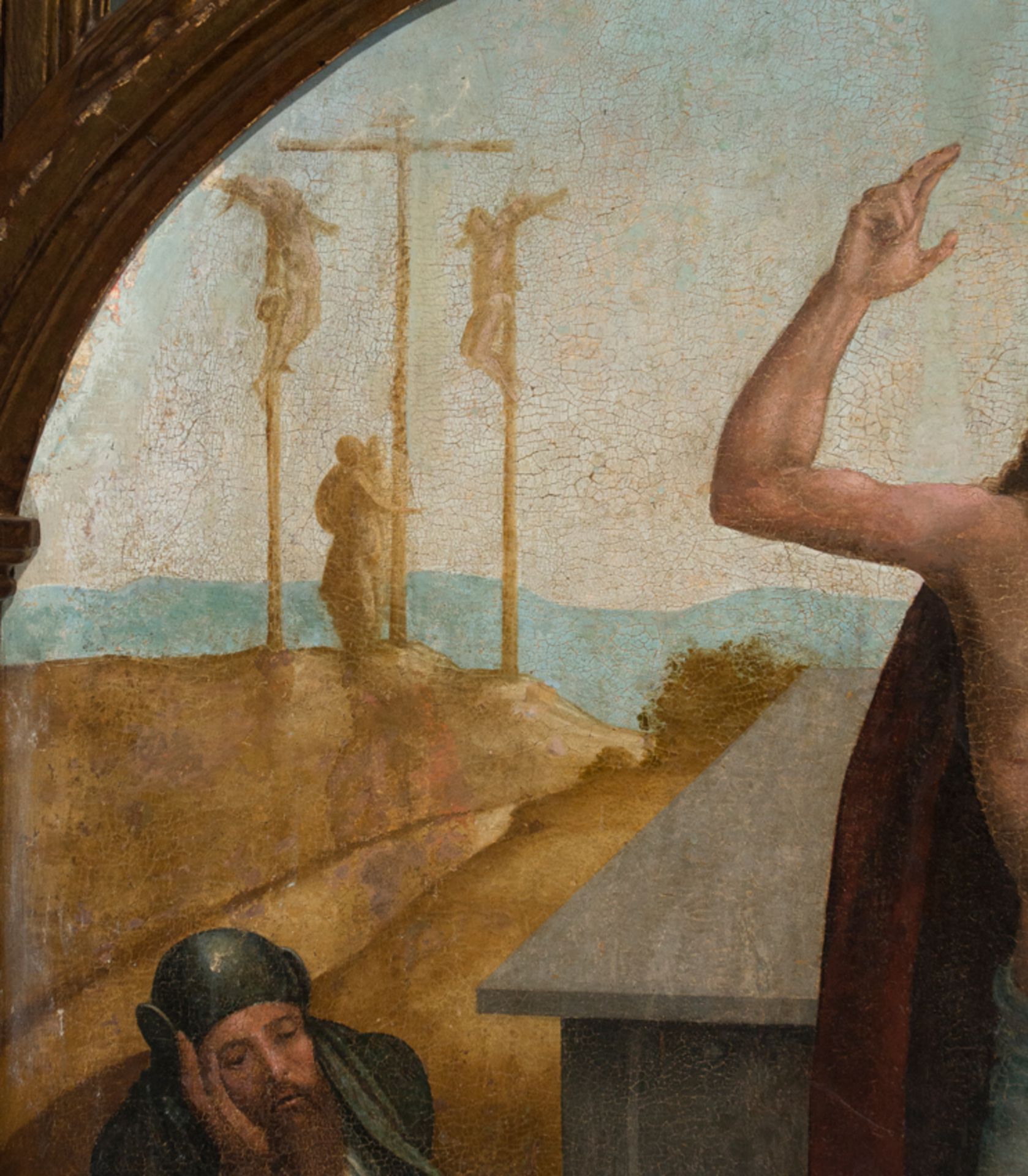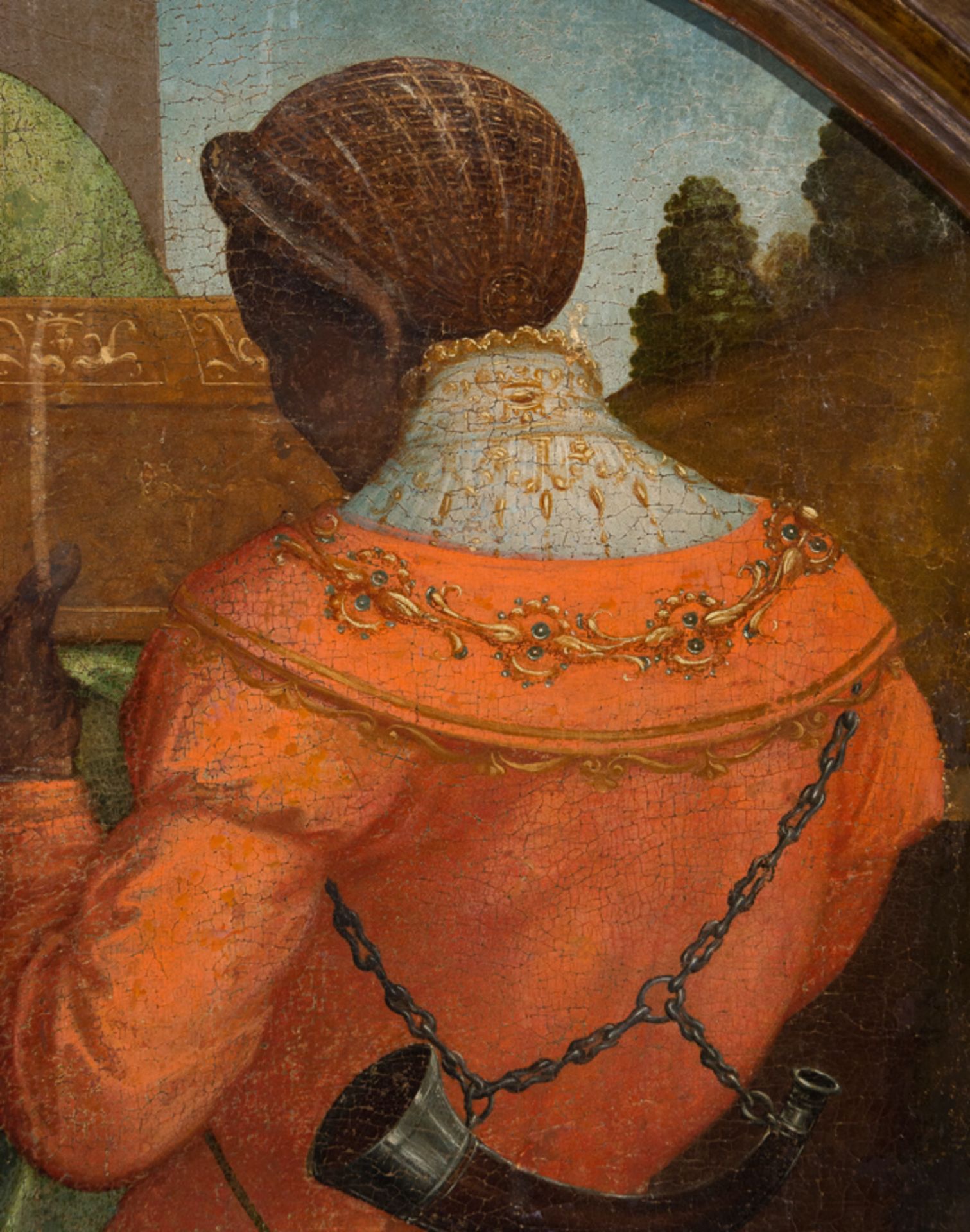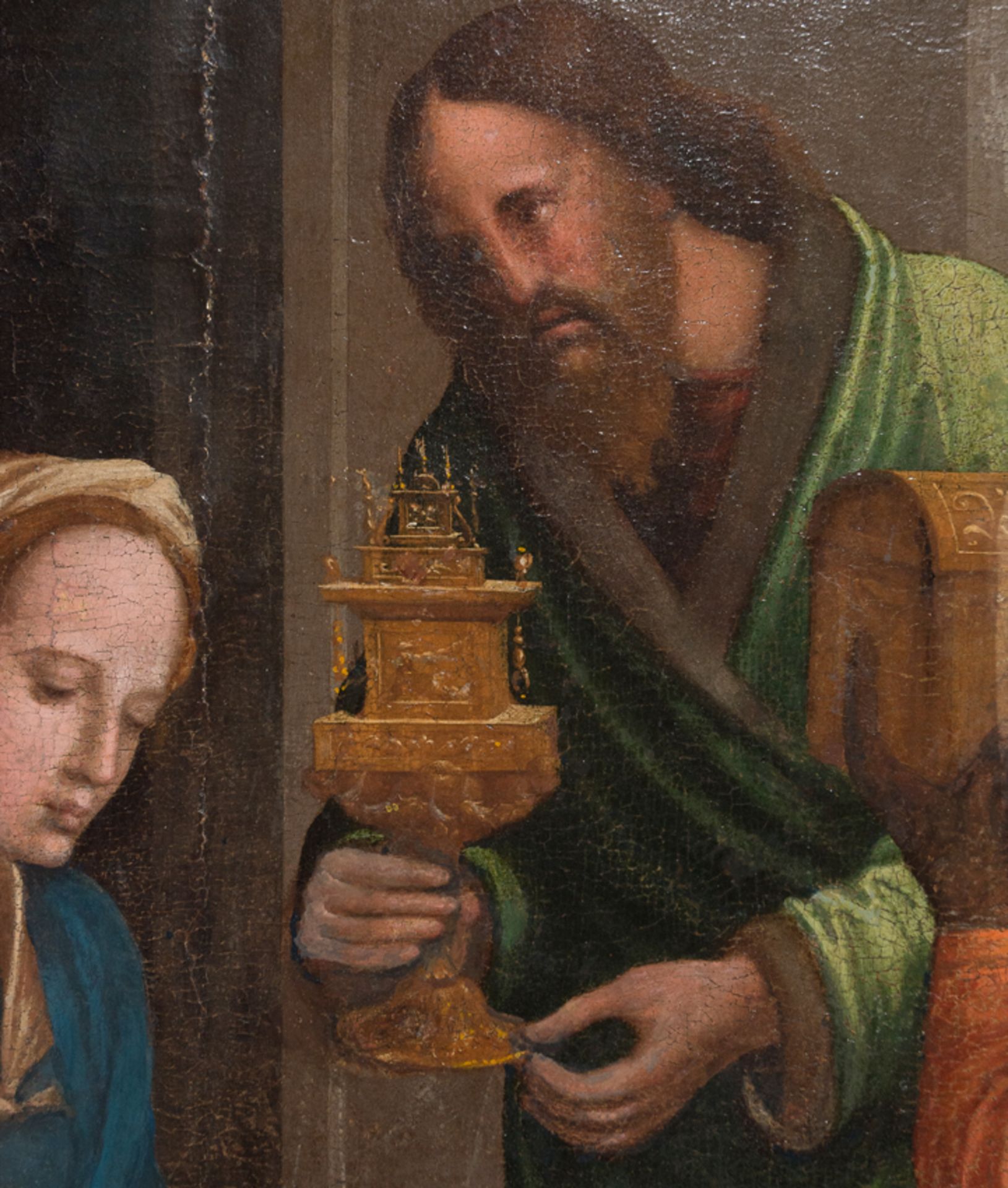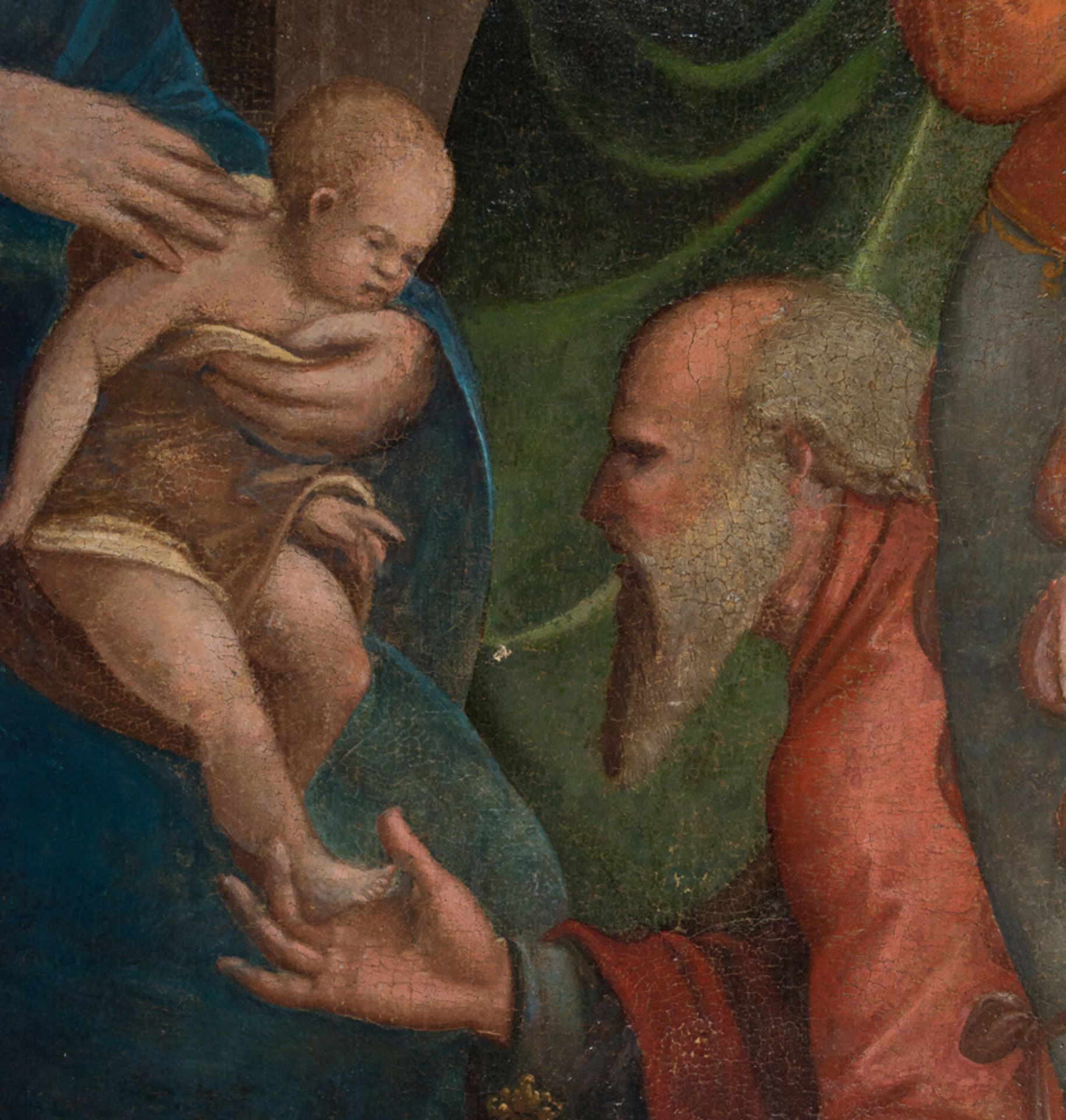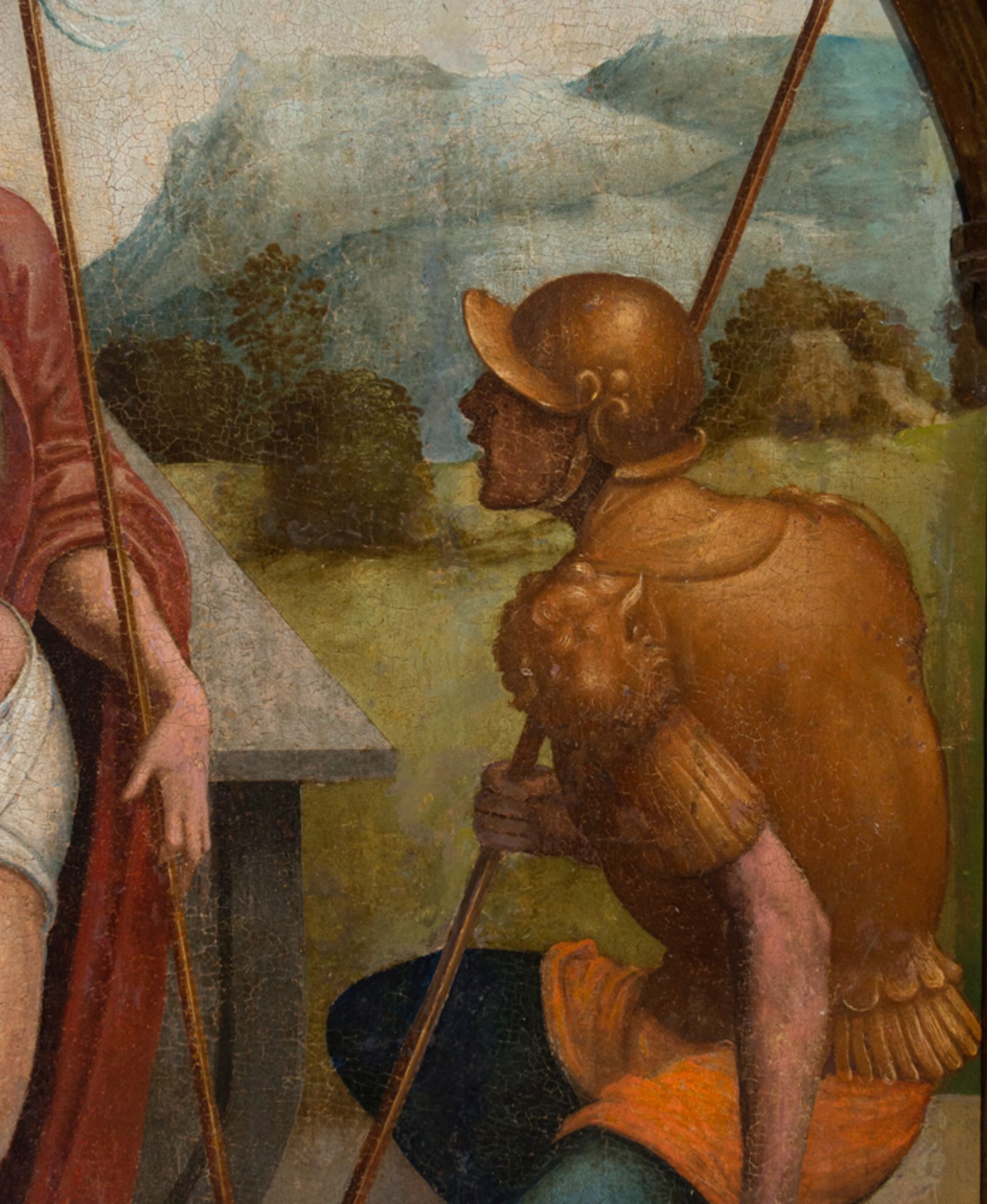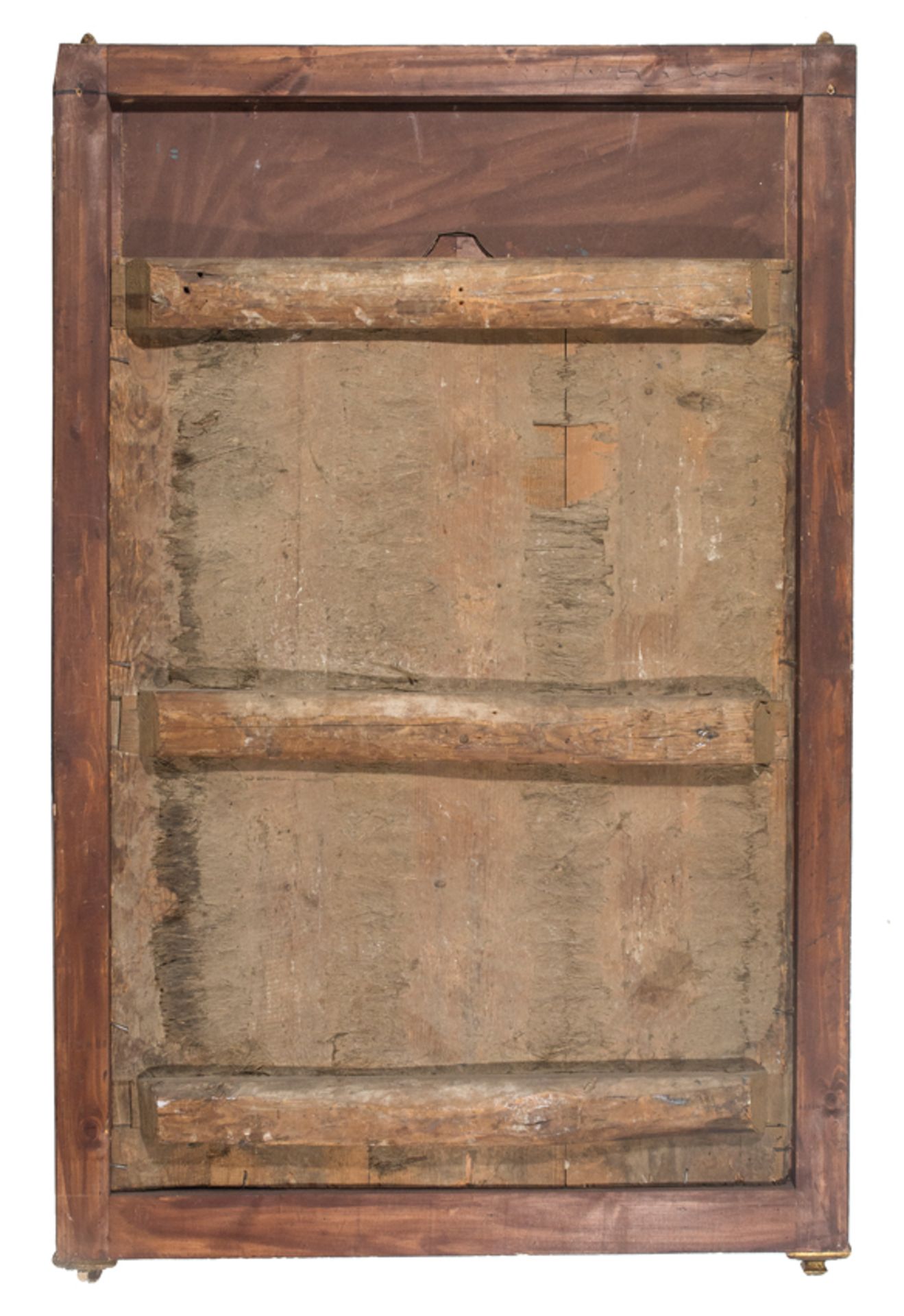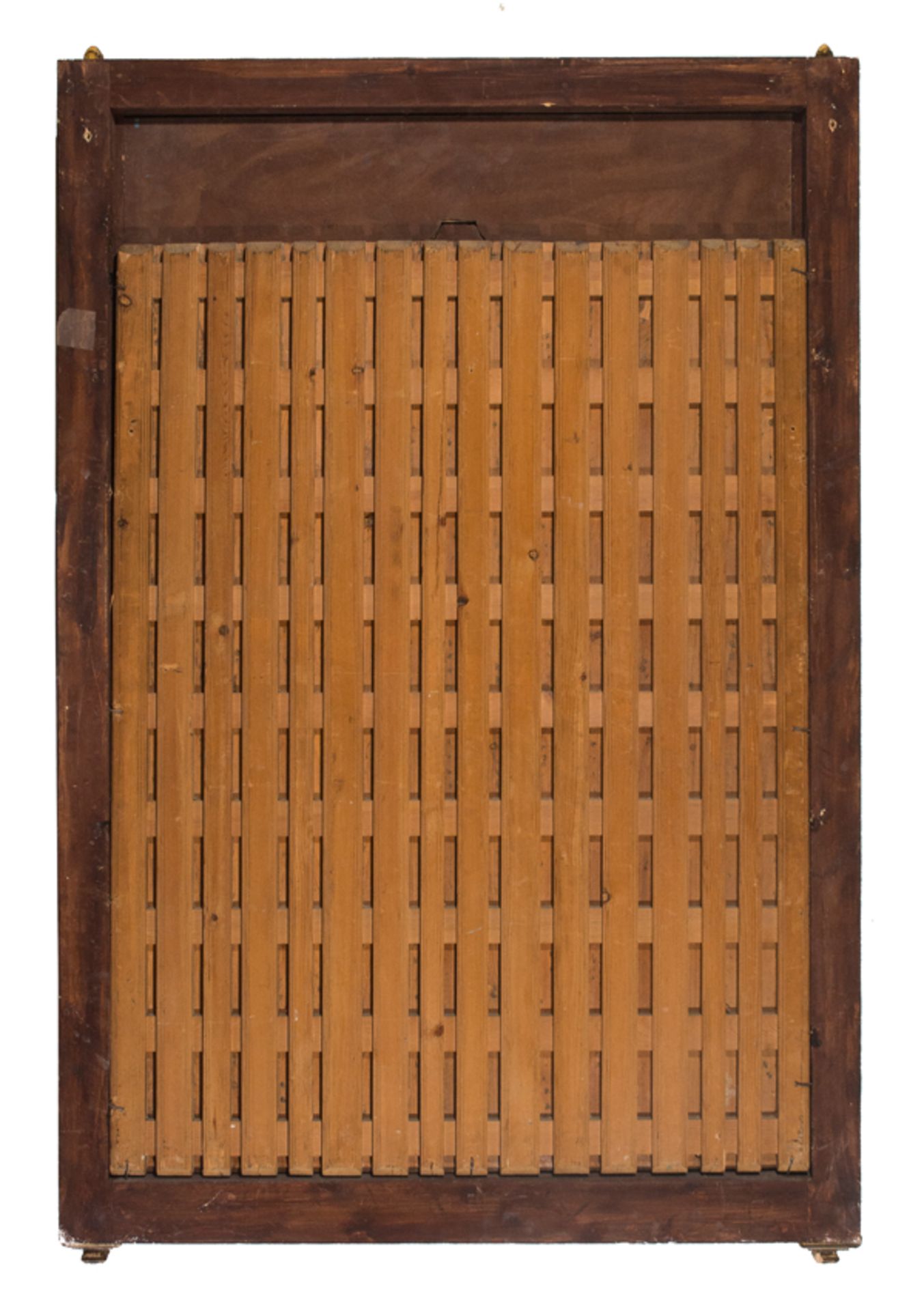14
"The Resurrection" and "The Adoration of the Magi"Anonymous from Castile, Spain. First third
"The Resurrection" and "The Adoration of the Magi"
Anonymous from Castile, Spain. First third of the 16th century.
Pair of oil on panel.
Size: 114,5 x 84 cm.
Size with frame: 148,5 x 99 cm.
The panel of the Resurrection, which comes from the same set as the Adoration of the Magi, has notable quality and classicism. The scene has been conceived using a rigorous axis of symmetry personified by the triumphant figure of Christ and the long tomb behind him. From then on, the anonymous painter has cleverly distributed the characters on both sides. Thus, the soldier lying down leaning on a kind of tree stump and with the stone at his side is echoed on the opposite side by a soldier sitting in a precarious position on a small staircase and carrying a spear and a shield. Above both characters we also see how they contrast and complement the golden landscape of Calvary, with the naked cross of Christ and the two thieves still on theirs, with the landscape on the right made of small clumps of forest and a fairly low, misty mountain. It is a soft landscape that fits seamlessly into the composition.
The Risen Christ is wrapped, mostly on his back and left arm, in a red tunic which takes the form of a vesica piscis, and wears a white loincloth gathered at the crotch. The figure of Christ is elegant and has an attitude that denotes decision and restrained power. His body, in a serpentine shape, is moving forward, a movement determined by the classic contrapposto arrangement of the legs – the right being placed behind. In his left hand he elegantly holds the symbolic banner of the Resurrection, while he raises his right hand towards the sky with his fingers arranged in an act of blessing. The anatomy of Christ is correctly modelled, though not with extreme detail. It is surprising that of the five stigmata, only the wound on the side is visible and rather indistinctly.
Between both soldiers there is a clear difference, and not only because of their physiques, attitudes, facial features or the postures that they adopt, but also because, while one been dressed in clothes more or less from the time the panel was painted, the other wears a type of armour that was thought to be worn in the period in which the sacred event took place. The panel already shows a clear Renaissance lexicon, such as the correct management of perspective, which the painter has achieved by placing some stones in the foreground with the tomb then being foreshortened, with its lines converging in the background. It is precisely in the choice of Christ’s strange tomb, a kind of inverted semi-circular tombstone closed by a flat, undecorated, rectangular slab, and in the armour of the soldier located on the left, armed with a spear and a cropped, leather-shaped shield, that a certain archaeological bent on the part of the painter can be perceived. The thoroughness with which he has captured both landscapes, especially that of the misty mountains, is interesting.
This delicate panel, in which there is a clear predominance of line over colour, applied in soft brushstrokes, achieving appropriate colour gradation to provide chiaroscuro effects, would have been made by a Castilian master from the first third of the 16th century.
The panel of the Adoration of the Magi, which comes from the same group as that of the Resurrection, presents a composition which was very recurrent since the Gothic, as we can see in numerous Flemish, Spanish or Italian panels. The Virgin is seated and holding the Child, in turn serving as his “throne”. Saint Joseph is absent from the composition. At their side, and forming almost the same group as the Virgin and Child, we find the three Magi arranged in different attitudes, and as usual, one of them is kneeling offering his present. On this occasion, due to his beard and grey hair, it is Melchior who offers the Child a luxurious cup containing gold, while Caspar will give him frankincense and Balthasar myrrh. The composition is developed within a classicist architecture in which a landscape has been painted in the background to the right to develop depth and perspective, also helping to achieve the optical interplay with the two-tone floor tiles.
The Virgin Mary has a rounded shape. She wears a tunic and a blue cloak as well as a white veil which covers most of her hair, which is tied at chest height. In both hands and on her lap she holds an amiable Christ Child. The Child is rather stylised and placed in a rather odd and unstable position in which he stretches out one of his legs in order to stroke King Melchior. His body is covered with a cloth which hides most of his nakedness.
To the right are the three Wise Men. To avoid monotony in the composition, the painter has shown the three characters in different postures. Thus, we have, as we already mentioned, Melchior kneeling, in profile and wearing luxurious clothes: a greyish tunic and reddish cloak. In front of him, with his back to the viewer, is Balthasar, who is standing and offering a gilded box decorated with grottos. He is the most interesting figure due to the extremely sumptuous clothing he is wearing (a doublet covered with an orange overcoat, galligaskins and white footwear), his unusual headgear, the sword which hangs from his belt and the horn which is held on his back by some chains. Finally, there is Caspar, who shyly moves towards the Christ Child with a gilded shine in which he carries his present, the myrrh. He has a stylised figure which sticks out in front of a hollow pilaster that is behind him. He wears a wide tunic covered in curved folds. He is bearded with brown hair which bestows him with great personality.
As with the other panel, we find a predominance of line over colour, although on this occasion the rich and varied colours that the painter has skilfully displayed and combined are striking: with powerful greens, oranges, reds and blues being cleverly graduated. The characters have oval faces, with tiny eyes and mouths, sharp noses and stylised hands. The painting must be the work of an interesting Castilian painter who developed his career during the first third of the 16th century.
We would like to thank Javier Baladrón, doctor in History of Art, for cataloguing this piece;
"The Resurrection" and "The Adoration of the Magi"
Anonymous from Castile, Spain. First third of the 16th century.
Pair of oil on panel.
Size: 114,5 x 84 cm.
Size with frame: 148,5 x 99 cm.
The panel of the Resurrection, which comes from the same set as the Adoration of the Magi, has notable quality and classicism. The scene has been conceived using a rigorous axis of symmetry personified by the triumphant figure of Christ and the long tomb behind him. From then on, the anonymous painter has cleverly distributed the characters on both sides. Thus, the soldier lying down leaning on a kind of tree stump and with the stone at his side is echoed on the opposite side by a soldier sitting in a precarious position on a small staircase and carrying a spear and a shield. Above both characters we also see how they contrast and complement the golden landscape of Calvary, with the naked cross of Christ and the two thieves still on theirs, with the landscape on the right made of small clumps of forest and a fairly low, misty mountain. It is a soft landscape that fits seamlessly into the composition.
The Risen Christ is wrapped, mostly on his back and left arm, in a red tunic which takes the form of a vesica piscis, and wears a white loincloth gathered at the crotch. The figure of Christ is elegant and has an attitude that denotes decision and restrained power. His body, in a serpentine shape, is moving forward, a movement determined by the classic contrapposto arrangement of the legs – the right being placed behind. In his left hand he elegantly holds the symbolic banner of the Resurrection, while he raises his right hand towards the sky with his fingers arranged in an act of blessing. The anatomy of Christ is correctly modelled, though not with extreme detail. It is surprising that of the five stigmata, only the wound on the side is visible and rather indistinctly.
Between both soldiers there is a clear difference, and not only because of their physiques, attitudes, facial features or the postures that they adopt, but also because, while one been dressed in clothes more or less from the time the panel was painted, the other wears a type of armour that was thought to be worn in the period in which the sacred event took place. The panel already shows a clear Renaissance lexicon, such as the correct management of perspective, which the painter has achieved by placing some stones in the foreground with the tomb then being foreshortened, with its lines converging in the background. It is precisely in the choice of Christ’s strange tomb, a kind of inverted semi-circular tombstone closed by a flat, undecorated, rectangular slab, and in the armour of the soldier located on the left, armed with a spear and a cropped, leather-shaped shield, that a certain archaeological bent on the part of the painter can be perceived. The thoroughness with which he has captured both landscapes, especially that of the misty mountains, is interesting.
This delicate panel, in which there is a clear predominance of line over colour, applied in soft brushstrokes, achieving appropriate colour gradation to provide chiaroscuro effects, would have been made by a Castilian master from the first third of the 16th century.
The panel of the Adoration of the Magi, which comes from the same group as that of the Resurrection, presents a composition which was very recurrent since the Gothic, as we can see in numerous Flemish, Spanish or Italian panels. The Virgin is seated and holding the Child, in turn serving as his “throne”. Saint Joseph is absent from the composition. At their side, and forming almost the same group as the Virgin and Child, we find the three Magi arranged in different attitudes, and as usual, one of them is kneeling offering his present. On this occasion, due to his beard and grey hair, it is Melchior who offers the Child a luxurious cup containing gold, while Caspar will give him frankincense and Balthasar myrrh. The composition is developed within a classicist architecture in which a landscape has been painted in the background to the right to develop depth and perspective, also helping to achieve the optical interplay with the two-tone floor tiles.
The Virgin Mary has a rounded shape. She wears a tunic and a blue cloak as well as a white veil which covers most of her hair, which is tied at chest height. In both hands and on her lap she holds an amiable Christ Child. The Child is rather stylised and placed in a rather odd and unstable position in which he stretches out one of his legs in order to stroke King Melchior. His body is covered with a cloth which hides most of his nakedness.
To the right are the three Wise Men. To avoid monotony in the composition, the painter has shown the three characters in different postures. Thus, we have, as we already mentioned, Melchior kneeling, in profile and wearing luxurious clothes: a greyish tunic and reddish cloak. In front of him, with his back to the viewer, is Balthasar, who is standing and offering a gilded box decorated with grottos. He is the most interesting figure due to the extremely sumptuous clothing he is wearing (a doublet covered with an orange overcoat, galligaskins and white footwear), his unusual headgear, the sword which hangs from his belt and the horn which is held on his back by some chains. Finally, there is Caspar, who shyly moves towards the Christ Child with a gilded shine in which he carries his present, the myrrh. He has a stylised figure which sticks out in front of a hollow pilaster that is behind him. He wears a wide tunic covered in curved folds. He is bearded with brown hair which bestows him with great personality.
As with the other panel, we find a predominance of line over colour, although on this occasion the rich and varied colours that the painter has skilfully displayed and combined are striking: with powerful greens, oranges, reds and blues being cleverly graduated. The characters have oval faces, with tiny eyes and mouths, sharp noses and stylised hands. The painting must be the work of an interesting Castilian painter who developed his career during the first third of the 16th century.
We would like to thank Javier Baladrón, doctor in History of Art, for cataloguing this piece;
"On Prophets, Saints and Princesses"
Auktionsdatum
Ort der Versteigerung
Generelle Versandinformationen vom Auktionshaus verfügbar
The purchase price includes the delivery of the lots in the venue of the auction. Transporting to other destinations is at the own risk of the client. The customer must contact "LST", to give the corresponding instructions for such transporting. "LST" is not responsible for the packaging or any accident incurred during transportation.
Wichtige Informationen
Aufgeld / Premium: 22 %
Live: 3 %
jeweils plus 21 % USt. / each plus 21 % VAT
AGB
CONDITIONS OF THE AUCTION:
I. REGISTRATION. To bid in the room customers must register at the beginning, filling out a form and picking a number that will identify them during the auction. Customers may be required to register in bank references or other guarantee system and if they do not prove the solvency "LST" will not accept bids and award the auction.
II. WRITTEN BIDS. "LST" will accept written bids, which will be formalized in the form provided by the room until the day before the auction. In such auctions, the room will bid in name of the client until the maximum stated in the offer and always at the lowest possible price. If there are two or more bids for the same amount, the one placed first will have the priority. Written bids received in advance, will have priority on the day of the auction.
III. TELEPHONE BIDS. "LST" will allow telephone bids, if interested people contact "LST" days before the auction providing personal data, ID card and the phone number which will be used by the staff of "LST" to call at the time of the auction. The buyer, within all the legal rights is making an offer for the asking price, when applies for telephone bid. "LST" will not take responsibility for any technical defects beyond its control, which may prevent to contact successfully the bidder during the auction.
IV. AUCTIONEER. The auction will be conducted by an auctioneer, director of the auction will be judge and arbitrator of it with full authority in its development, will award the lots to the highest bidder and is able to settle any controversy concerning lots sale, reject bids, divide lots or group them and remover objects from the room. Will be able to, if it is deemed suitable, not accept bids on the auction. His decision will be unappealable.
V. SALE OF LOTS. The lots are awarded to the highest bidder. Once the auctioneer blows the hammer, the buyer becomes responsible of the lot purchased, exempting "LST" of liability to for any damage and / or accidents that may occur. No refunds of lots.
VI. STARTING PRICE. The amount shown in the catalogue as the starting price for each lot will be, as a rule, the minimum selling price, except for exceptional cases where a reservation may be agreed upon with the seller or it set discretionary by the room.
VII. SCALE OF BIDS. The bids are set according to the following scale:
From 50.-€ to 200.-€…………………………………………..at 10.-€
From 200.-€ to 500.-€…………………………………… …25 in 25.-€
From 500.-€ to 1.000.-€………………………………..…..….50 in 50.-€
From 1.000.-€ to 2.000.-€………………………………..…100 in 100.-€
From 2.000.-€ to 5.000.-€……………………………….….250 in 250.-€
From 5.000.-€ to 10.000.-€…………………………………500 in 500.-€
From 10.000.-€ to 20.000.-€……………………………1.000 in 1.000.-€
From 20.000.-€ to 50.000.-€……………………………2.500 in 2.500.-€
From 50.000.-€ to 100.000.-€…………………………..5.000 in 5.000.-€
From 100.000.-€ to 100.000.-€………………………10.000 in 10.000.-€
From 200.000.-€ to 200.000.-€………………………25.000 in 25.000.-€
From 500.000.-€ to 500.000.-€………………………50.000 in 50.000.-€
VIII. RIGHT OF ADMISION. "LST" reserves the right to admission to the auction room and to reject, at its judgment, any purchase order, from clients whose solvency is not duly proved as well as not to sale auctions.
IX. SALE PRICES. The successful bidder of one or more lots must pay "LST" the final sale price achieves at auction, plus the 22 % plus 21% VAT on the commission, at total 26,62 % on Hammer Price.
X. CATALOG DATA. The catalogue data are obtained in order to careful research and advice, however, any responsibility is afforded about its accuracy. The lots will be auctioned in the state in which they are, not accepting any claims in restorations, breakage, damage, imperfections and, even description or numbering mistakes in the catalogue, in case of it, being the burden of the buyers to make sure before the auction that the description matches with their personal opinion about respective lot. The exhibition of the lots is intended to allow a perfect review and study of them.
XI. PAYMENT AND REMOVAL OF LOTS. Payment and removal of the lots will be held no later than five days following the auction. After this period expire without having the buyer removed the lot or lots purchases, it will accrue an expense of custody of 6 euros per day on each lot.
15 days after the auction without having the buyer paid and removes the sold lots, "LST" will inform the seller and there will begin judicial proceeding in order to obtain payment. The delay in payment by the purchaser of his/her sold lots will carry an interest increase at a rate of 1,5% per month.
XII. DELIVERY OF LOTS. The purchase price includes the delivery of the lots in the venue of the auction. Transporting to other destinations is at the own risk of the client. The customer must contact "LST", to give the corresponding instructions for such transporting. "LST" is not responsible for the packaging or any accident incurred during transportation.
XIII. RIGHT OF FIRT REFUSAL AND REPURCHASE. "LST" in order to article 38 of "Ley 16/1985 de 25 Junio del Patrimonio Histórico Español" (BOE. 155 June 29, 1985), will notify in advance to the Ministry of Culture, the content of their catalogues. Concerning the lots subject to the legislation referred to in the preceding paragraph, the Administration may exercise the rights of first refusal and repurchase according to the law. "LST" will watch over the protection of Artistic, Historical and Bibliographical Heritage of Spain. For customers out of European Community, a tax for export is required by the Administration.
XIV. VALUE ADDED TAX (I.V.A). This tax will be accrued on commissions of "LST" for buyers, using the rates prevailing on the date of the auction.
XV. DATA PROTECTION. In order to the "Ley 15/1999 de 13 de Diciembre, de Protección de Datos de Carácter Personal", the client authorize "LST", the inclusion of their data in a customer file, and for the promotion by "LST" of the objects at all times the rights of access, rectification or deletion of personal data by sending the appropriate request to the following address: LA SUITE SUBASTAS, C/ Conde Salvatierra, 8, 08006. Barcelona.
XVI. EXPRESS LEGAL JURISDICTION. These Conditions are governed by and interpreted in accordance with the rules of Spanish law. The mere act of participating in the auction as seller, buyer or bidder, implies acceptance of these Terms and Conditions.
Sales operations are understood to be held at the registered office of "LST", C/ Conde de Salvatierra, 8, 08006. Any dispute shall be taken to the competent courts of Barcelona, expressly waiving any other jurisdiction, in accordance with Article 55 of the "Ley de Enjuiciamiento Civil".


































